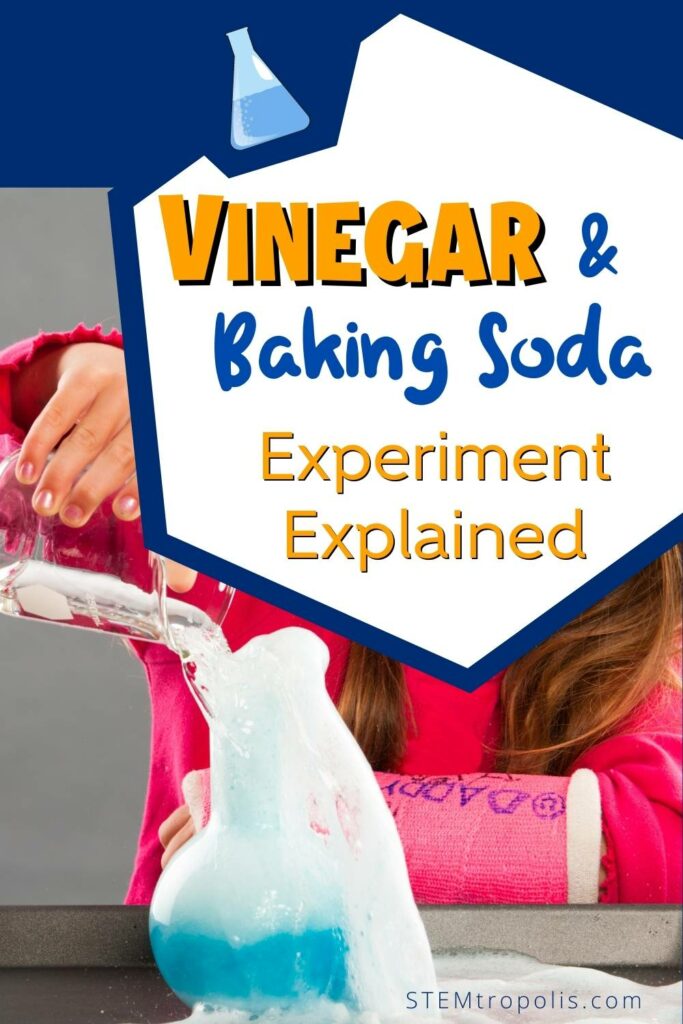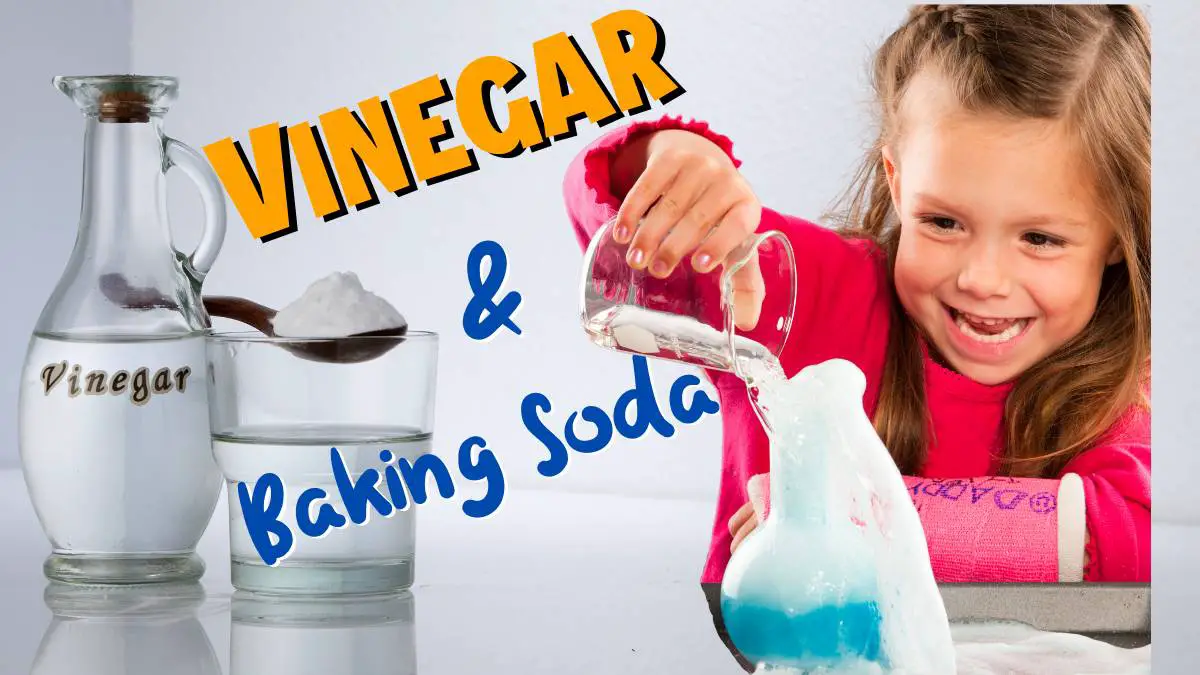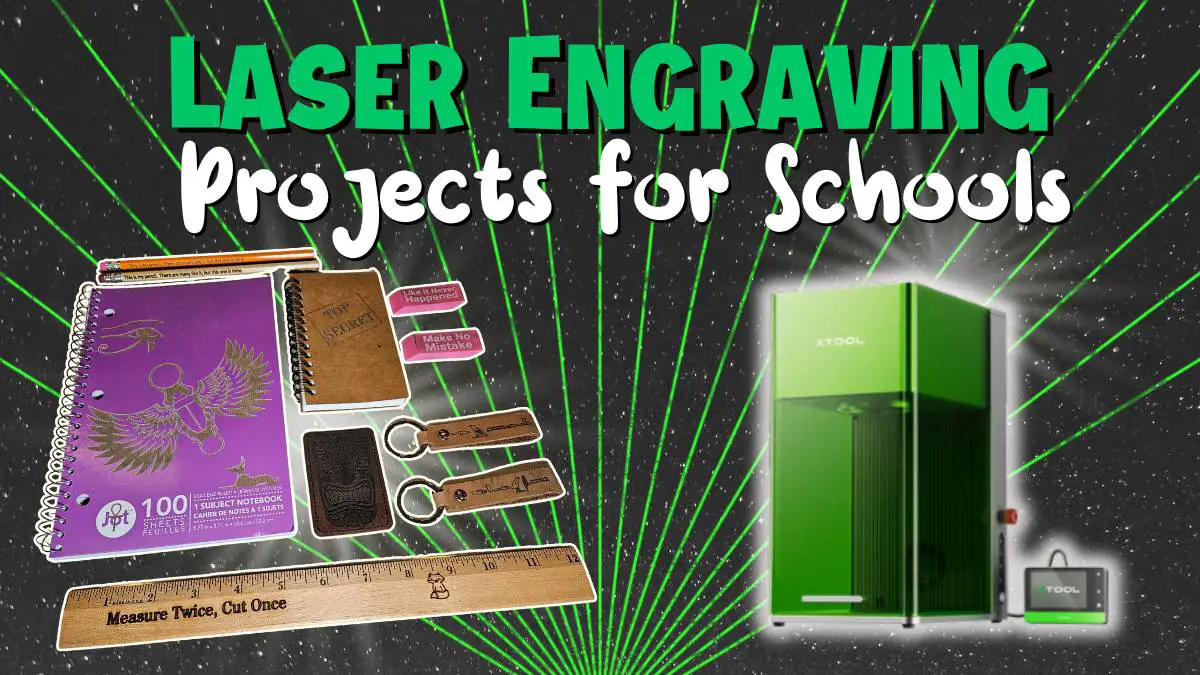From creating bubbling volcanoes to exploring the properties of acids and bases, vinegar and baking soda offer fun opportunities for hands-on learning and experimentation.
So grab a bottle of vinegar and a box of baking soda, and get ready to have some fun! We’ll explore some of the many experiments and activities you can do with these two versatile ingredients. Get ready to be amazed by the science behind the fizz!
The Science and Chemistry of Vinegar and Baking Soda
The reaction between vinegar and baking soda is often used in science experiments to demonstrate chemical reactions or to create a gas that can be used to inflate a balloon or make a homemade volcano. It’s a simple and fun way to explore chemistry and learn about the properties of acids and bases., and we’ve done experiments with this chemical reaction a bunch of times.
Okay, that’s great and all – we know it ‘s a safe experiment that make a fizzy reaction. What’s actually happening? What’s the science behind simply combining these two ingredients?
The reaction between vinegar and baking soda is a classic chemistry demonstration that produces carbon dioxide gas. When vinegar and baking soda are mixed together, the acidity of the vinegar reacts with the basic nature of the baking soda to produce a chemical reaction. The reaction produces carbon dioxide gas, which causes the mixture to bubble and foam.
In this case, the acid is the vinegar (acetic acid) and the base is the baking soda (sodium bicarbonate). The salt produced in the reaction is sodium acetate, and the water is produced as a byproduct of the reaction. Here are the compounds involved:
- CH3COOH: acetic acid (vinegar)
- NaHCO3: sodium bicarbonate (baking soda)
- CH3COONa: sodium acetate
- H2O: water
- CO2: carbon dioxide gas
The chemical equation for combining vinegar (acetic acid) and baking soda (sodium bicarbonate) is:
CH3COOH + NaHCO3 → CH3COONa + H2O + CO2
This reaction produces water, carbon dioxide gas, and sodium acetate (CH3COONa). This produces carbon dioxide bubbles, as the production of carbon dioxide gas is what gives the mixture its characteristic fizzing and bubbling. The overall reaction can be written as an acid-base reaction, with the acetic acid (vinegar) acting as the acid and the baking soda acting as the base.
Activities with Vinegar and Baking Soda
The kids always enjoy seeing the foam fizz up. We usually need to do it multiple times so they each get a turn pouring in the vinegar.
Remember to have some paper towels or rags on hand! You can do what you can to try and contain the fizz and the mess, but always expect to be wiping up and prepare before you start mixing.
Make a Volcano
This is the classic experiment everyone thinks of with vinegar and baking soda. It’s the go to experiment for good reasons:
- It’s quick and easy to do
- It doesn’t involve harsh chemicals
- It uses common kitchen ingredients
- It’s very visual
Place a small amount of baking soda and a paper cup or small glass (many science experiment or STEM kits include a plastic volcano specifically for this experiment.) In a separate cup or glass, add a few drops of red food coloring and some vinegar. Slowly pour vinegar over the baking soda. Watch as the mixture fizzes and bubbles, creating a “volcano” effect.
The exact amount isn’t vital, though you can use a 1:1 ratio (equal parts of each) for a starting point. So, mixing 2 tablespoons of vinegar with 2 tablespoons of baking soda will give you a good reaction. The more of both you uses, the bigger the reaction will be!
Apple Volcano
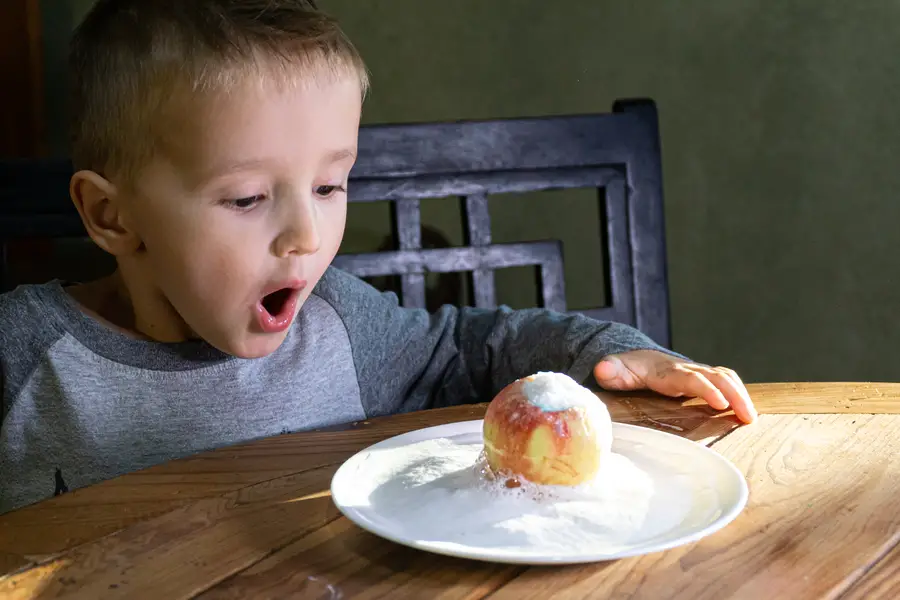
During our experiments with apples, we cored out an apple to use as a variation of the classic volcano. We placed the baking soda in the apple and poured the vinegar over it.
Create a fizzy reaction
You don’t always have to make a volcano. Just mixing equal parts vinegar and baking soda in a small container will still provide the same demonstration. Observe the fizzing and bubbling that occurs as the two substances react.
Try adding a few drops of food coloring for different effects or occasions! Green bubbling cauldrons are great for Halloween!
Inflate a Balloon
Most people fixate on the fizz and foam created when doing this experiment. The byproduct of the vinegar solution is carbon dioxide gas, which is invisible. By sealing the reaction in a closed space, we can “see” the results as the balloon gets inflated. Check it out in our experiments with plastic bottles.
Pro tip: make sure your balloon doesn’t have a hole in it!
Vinegar and Baking Soda Rocket Fuel
If you tried the experiment to inflate a balloon, you saw how the byproduct gas expands and inflates the balloon. What if there was no where for the gas to expand? It’d create increased pressure in a confined space until it stopped expanding – or it’d build up enough pressure to expand further.
We can use that pressure (and release) as rocket fuel!
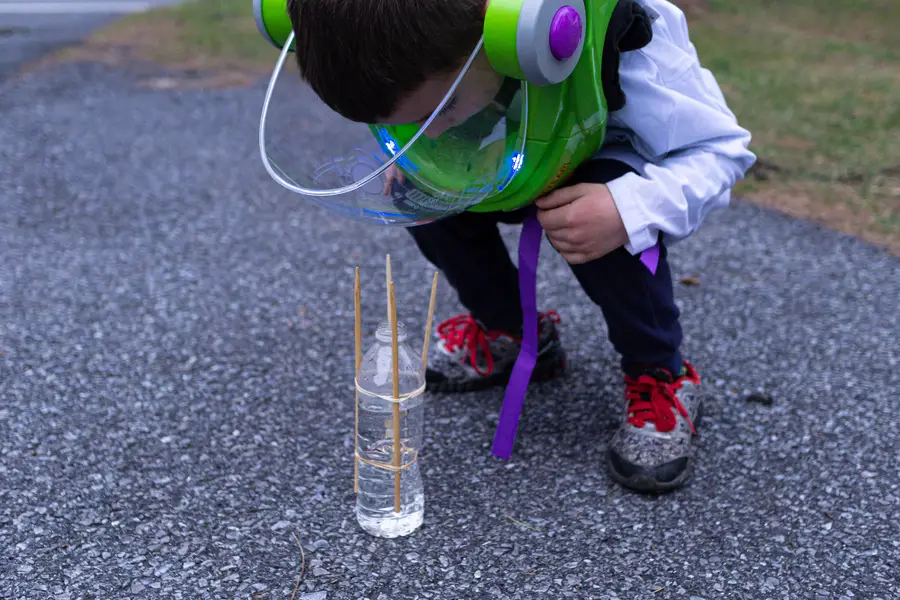
Materials needed:
- Recycled plastic bottle
- Baking soda
- Vinegar
- Cork
- Fins or a stand for the bottle
Important – you’ll definitely want to do this experiment outside with enough space for your rocket to shoot skyward and come back down.
Steps:
- Grab an empty plastic bottle
- fashion some fins from sturdy cardboard, or build some legs for the rocket. We simply used 3 chopsticks held in place by a rubberband to support the rocket for launch.
- Add 2-3 tablespoons of baking soda into the plastic bottle.
- Pour vinegar into the bottle until it’s about 1/3 full.
- Quickly insert a cork into the opening of the bottle.
- Flip the bottle upside down so the cork is on the bottom and the rocket is resting on the fins or support.
- Place the bottle on a flat surface, step back, and watch it launch!
The reaction between baking soda and vinegar produces carbon dioxide gas, which creates pressure inside the corked bottle. This pressure builds up until it’s strong enough to push the cork out of the opening, propelling the bottle upwards. The fins at the bottom of the bottle provide stability and keep the rocket flying straight.
Check this out and more in our post on experiments with plastic bottles.
Explore the properties of acids and bases
Mix different amounts of vinegar and baking soda to see how the strength of the acid or base affects the reaction. You can also try using different types of vinegar (such as apple cider vinegar or white vinegar) to see how they compare.
As you make small tweaks, note the effects of each. Remember to use the scientific method and make a hypothesis before testing it!
Invisible Ink with Vinegar and Baking Soda
You can use the leftover mixture form one of the above experiments as invisible in!
Materials:
- White paper
- Vinegar & Baking Soda Mixture
- Paint brush or Q-tip
- Candle or light bulb
Follow these steps:
- In a bowl, mix equal parts of baking soda and water until the baking soda is fully dissolved. (Or use the leftover solution from one of the experiments above.)
- Dip a paint brush or Q-tip into the baking soda mixture and use it to write a secret message or draw a picture on the paper.
- Allow the paper to dry; the baking soda mixture will dry clear and the message will be invisible.
- To reveal the message, hold the paper close to a candle or light bulb.
Make a Ball
Combine a small amount of vinegar and a larger amount of baking soda in a bowl. Slowly add cornstarch until the mixture forms a dough-like consistency. Roll the dough into a ball and watch as it bounces. (Don’t expect it to be super ball level bouncy; it’s more of an experiment than a toy.)
Materials needed:
- Vinegar
- Baking soda
- Cornstarch
- Bowl
- Measuring spoons
- Spoon for mixing
- Surface for rolling the dough
Steps:
- Measure out 1 tablespoon of vinegar and 4 tablespoons of baking soda.
- Add the vinegar to a bowl.
- Slowly add the baking soda to the bowl while stirring continuously. This will create a foaming reaction.
- Continue stirring until the mixture stops foaming and becomes a paste.
- Slowly add cornstarch to the mixture while stirring until it forms a dough-like consistency.
- Remove the dough from the bowl and knead it with your hands until it becomes smooth.
- Roll the dough into a ball.
Science involved: When vinegar (acetic acid) and baking soda (sodium bicarbonate) are mixed together, they undergo a chemical reaction that produces carbon dioxide gas. This gas gets trapped in the dough-like mixture formed by adding cornstarch, causing the mixture to expand and become bouncy.
The carbon dioxide gas produced creates bubbles in the dough-like mixture, making it bouncy. The more baking soda you add, the more carbon dioxide gas is produced, resulting in a bigger and bouncier ball. The cornstarch helps to bind the ingredients together and create a dough-like consistency.
Note: if you’ve done a volcano kind of experiment, you can make further use of that mixture by slowly adding the corn starch to it until it’s doughy enough to shape into a ball.
Wrap Up – Vinegar Experiment with Baking Soda
This reaction is at the core of many classic science experiments, and it’s one of our favorites. The key ingredients are easily found in most kitchens as the setup is easy. With a few variations, you can use this for fun seasonal experiments and demonstrate several different science and chemistry concepts.
Don’t just dump the mixture when you’re done. A cup of vinegar and baking soda can be an effective cleaning agent! (Just don’t clean anything that food coloring may stain.)
Check out our STEM challenges with household products for more quick and easy experiments for kids, and check out our kitchen science experiments!
